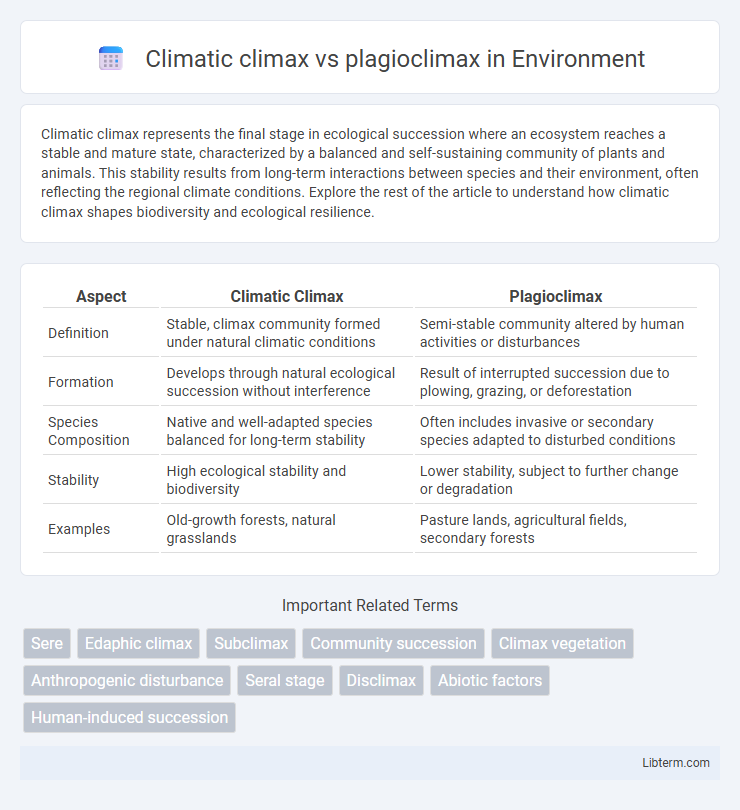Climatic climax represents the final stage in ecological succession where an ecosystem reaches a stable and mature state, characterized by a balanced and self-sustaining community of plants and animals. This stability results from long-term interactions between species and their environment, often reflecting the regional climate conditions. Explore the rest of the article to understand how climatic climax shapes biodiversity and ecological resilience.
Table of Comparison
| Aspect | Climatic Climax | Plagioclimax |
|---|---|---|
| Definition | Stable, climax community formed under natural climatic conditions | Semi-stable community altered by human activities or disturbances |
| Formation | Develops through natural ecological succession without interference | Result of interrupted succession due to plowing, grazing, or deforestation |
| Species Composition | Native and well-adapted species balanced for long-term stability | Often includes invasive or secondary species adapted to disturbed conditions |
| Stability | High ecological stability and biodiversity | Lower stability, subject to further change or degradation |
| Examples | Old-growth forests, natural grasslands | Pasture lands, agricultural fields, secondary forests |
Understanding Climatic Climax: Definition and Concepts
Climatic climax refers to a stable and mature ecological community that develops through natural succession, where vegetation and environmental conditions reach equilibrium with the climate of the region. In contrast, a plagioclimax occurs when human activities, such as agriculture or deforestation, interrupt natural succession, resulting in a suboptimal or artificial community that differs from the potential natural climax. Understanding climatic climax involves recognizing the interplay between long-term climate patterns and vegetation dynamics that shape the ultimate, self-perpetuating ecosystem.
The Role of Climate in Determining Vegetation Climax
Climate plays a crucial role in determining vegetation climax, where a stable ecological community reaches its final stage known as the climatic climax, shaped primarily by regional climate conditions such as temperature and precipitation patterns. In contrast, a plagioclimax represents a community altered by human activities or disturbances, preventing it from reaching its natural climatic climax despite suitable climatic conditions. Understanding the distinction between climatic climax and plagioclimax highlights the impact of climate stability versus anthropogenic factors on vegetation succession and ecosystem maturity.
Plagioclimax: Human Influence on Ecological Succession
Plagioclimax occurs when human activities such as agriculture, deforestation, or urban development interrupt natural ecological succession, preventing an ecosystem from reaching its climatic climax stage. This alteration results in a stable but artificially maintained community dominated by species adapted to disturbed environments, often with reduced biodiversity compared to the climax community. Understanding plagioclimax highlights the significant impact of anthropogenic factors on ecosystem dynamics and long-term vegetation patterns.
Key Differences Between Climatic Climax and Plagioclimax
Climatic climax represents a stable, mature community in ecological succession determined primarily by the climate of the region, leading to a predictable vegetation type such as a forest in temperate zones. Plagioclimax occurs due to human intervention or disturbances like grazing, farming, or deforestation, which prevent natural succession and maintain an altered, less stable vegetation state. The key difference lies in climatic climax reflecting natural, undisturbed ecological maturity while plagioclimax results from anthropogenic impact disrupting natural development.
Natural vs. Managed Ecosystems: A Comparative Analysis
Climatic climax represents a stable, self-sustaining ecosystem shaped primarily by natural climatic conditions, often characterized by mature forests or grasslands in equilibrium with local climate. Plagioclimax occurs in ecosystems altered by human activities such as agriculture, grazing, or forestry, resulting in communities maintained in a sub-climatic state through continuous disturbance. Comparing natural climatic climax with managed plagioclimax ecosystems highlights the influence of anthropogenic factors on biodiversity, succession dynamics, and ecosystem resilience.
Examples of Climatic Climax Communities Across Biomes
Tropical rainforests represent a classic climatic climax community characterized by high biodiversity and stable conditions maintained over time, such as the Amazon Basin. Temperate deciduous forests, like those in the eastern United States, serve as another example with species adapted to seasonal changes and mature, self-sustaining ecosystems. In contrast, plagioclimax communities result from human activities preventing succession, but true climatic climax communities demonstrate natural vegetation development specific to each biome's climate and soil conditions.
Common Plagioclimax Communities Caused by Human Activities
Common plagioclimax communities often arise in grasslands, heathlands, and woodlands due to activities such as agriculture, grazing, and frequent burning. These human disturbances prevent ecosystems from reaching their climatic climax, maintaining vegetation compositions dominated by species tolerant of repeated disruption. Examples include overgrazed grasslands dominated by invasive grasses or heathlands sustained by controlled burning to preserve biodiversity.
Ecological Implications of Climax Disruption
Climatic climax represents a stable, mature ecosystem shaped primarily by regional climate, whereas a plagioclimax occurs when human activities or disturbances prevent natural succession, resulting in an altered community structure. Disruption of the climatic climax through deforestation, agriculture, or urbanization leads to loss of biodiversity, reduced ecosystem resilience, and impaired ecological functions like nutrient cycling and habitat provision. Restoration efforts aiming to revert plagioclimax areas toward their climatic climax state can enhance ecosystem services and promote long-term environmental stability.
Conservation Strategies: Maintaining Climax and Plagioclimax
Conservation strategies for climatic climax focus on preserving natural succession stages and protecting stable ecosystems with mature vegetation and biodiversity. Managing plagioclimax involves controlling human activities like grazing, fire, and land use to maintain altered but stable ecosystems that differ from the natural climax state. Restoration practices may include reforestation or invasive species removal to support the transition toward a true climatic climax or sustain plagioclimax habitats valuable for specific wildlife and ecological functions.
Future Perspectives: Climate Change and Successional Pathways
Climatic climax communities represent stable ecosystems adapted to regional climate conditions, while plagioclimax communities result from human disturbances altering natural succession. Climate change disrupts traditional successional pathways by shifting temperature and precipitation patterns, potentially preventing ecosystems from reaching their historical climatic climax. Future perspectives emphasize the need for adaptive management strategies that consider altered disturbance regimes and promote resilience in both climatic climax and plagioclimax systems under changing environments.
Climatic climax Infographic

 libterm.com
libterm.com